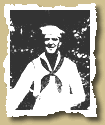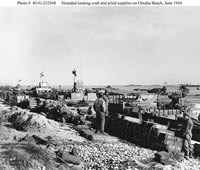| The Assault | Timeline | Maps | Men of D-Day | Photos |

|
We off loaded our ship some ten miles out to sea at 6am, June 6, 1944. I was a member of the 6th Beach Battalion, Company B. We proceeded to the beach in a LCM landing craft. Upon arriving about a mile off shore we were ordered to circle. At 7am we were instructed to proceed to our assigned beach, draw number 3. Our landing craft was the first to head to Fox Green Beach and we were immediately fired upon about 200 yards from the beach. Our craft hit a mine that blew the front of the boat clear out of the water at the same time we were hit with 88mm shells from the beach. It was then that I found myself in the water over my head with a full pack on my back. Some how I made it to the beach behind a headgehog which gave me some cover. There were bodies, body parts and blood everywhere. I proceeded up the beach on my knees and elbows where I came across a Army medic and helped him with the wounded. The enemy was firing at us with machine guns, mortars and 88mm cannon from all directions. There were more killed and wounded on the beach than those of us left alive. I finally made to the dune line in fair shape and this offered us a bit of protection. An Army captain then ordered me to the top of the dune line to fire my rifle at the enemy. We could see the Germans moving around as there was no one firing at them. For a sailor, I was pretty good shot with my World war I Springfield 30-06 rifle.
During the first three days it seemed that the Germans never stopped firing at us. Even though our army pushed them back the enemy still had artillery that could reach us. To this day I have felt very lucky and thankful that, after 28 days on the beach, I wasn't killed. Robert Watson (January 20, 2008) |
| |

